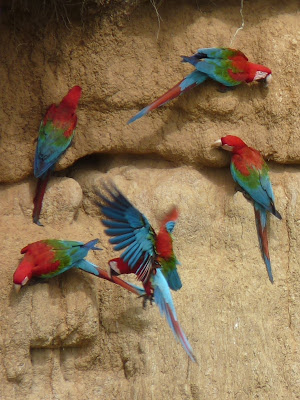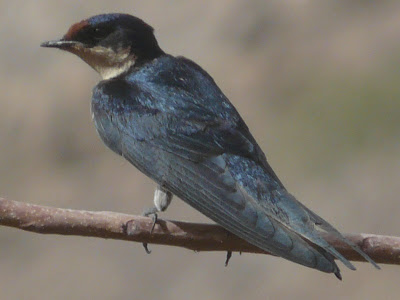I think it's time to introduce another chapter in our intermittent discussion of Colours in Nature - you can find the others from that most recent one. As soon as I started preparing for some musings on blue in nature, I realised that yet again one posting wasn't going to nearly cover it. At this stage I anticipate two on animals and one on plants, but I've been wrong before...
It is a bit of a shock to realise that it's becoming increasingly likely that there are no blue pigments in any terrestrial vertebrates! As I suggest in the title it's all a trick, by an array of complex structural mechanisms wherein small 'bubbles' in skin or feathers or shell allow longer wavelengths (reds, oranges, yellows) to pass through but are of a size to 'trap' shorter wavelengths - specifically blues - and reflect them back to us. The principal is known as Tyndall scattering after 19th century Irish-born British physicist John Tyndall who described it; the effect is often seen with very fine particles suspended in liquid, such as very fine silt in rushing streams or the iris of a blue eye. There are variations too, but this isn't a physics blog...
| Male White-winged Fairy-wren Malurus leucopterus, north-western New South Wales. |
The male White-winged Fairy-wren, sitting up on a saltbush in its vast plains habitat, shines like a light. However if you were to find a shed feather, and crush it, you'd find it turned from shining blue to a indeterminate dirty-whitish, as the crucial little bubbles were broken. Let's just admire a few of the results of this extraordinarily subtle and precise application of wave physics in the feathers of some of the most glorious birds I've seen. Some, like the wren above, are mostly blue; others feature blue highlights that stand out from the surrounding contrasting colours.
 |
| Red-and-Green Macaws Ara chloropterus, Blanquillo clay lick, Peru. I've never understood why the green was selected above the blue for the name, but I guess either would have been inadequate alone. |
| Masked Tanager Tangara nigrocincta, rainforest canopy, Sacha Lodge, Ecuador. The tanagers have among the widest colour ranges of any bird group; blue of course features. |
So far, all of these blue birds look uniformly blue no matter how you look at them, as you might expect. However that is not true of all blue birds by any means.
| Male Satin Bowerbird Ptilonorhynchus violaceus, Canberra. From some angles he can look dull black, then suddenly he turns and flashes deep glossy blue. |
This is iridescent colouring, and the principle is different from non-iridescent colours. Here the thin surface of the feather is transparent, but beneath it is a layer of melanin. Some light reflects from the surface, more of it bounces back from the melanin layer; if the waves coincide, peak to peak, the colour is dramatically emphasised, but if peak and trough are adjacent the waves cancel each other, and the feather appears black. From one vantage point the effect is consistent, but as the observer and the feathers move, the angle changes and so does the colour. In the bowerbird above, his front half looks blue but the rest seems black; a second later and the the effect could be reversed. The actual colour is determined by the depth of the melanin layer, which decides the wavelength of the reflected light.
Here are some examples.
 |
| Leaden Flycatcher Myiagra rubeculamale, National Botanic Gardens Canberra. This one took me by surprise; normally he is a dull leaden grey, but he suddenly caught the sun and lit up. |
 |
| Cape Glossy Starling Lamprotornis nitens, Etosha National Park, Namibia. Some starlings are among the most dramatic of iridescent birds. Even they however, cannot outdo the hummingbirds... |
| Great Sapphirewing Pterophanes cyanopterus, Yanacocha Reserve, Ecuador. It was hard to pick just one iridescent blue hummingbird, but this is a pretty good representative. |
There are of course iridescent feathers in many other colours, but that's another story (and one which will be told, in its time).
That's also enough for today, but next time I want to explore other blue body parts - skin, scales, beaks, legs, insect wings etc. That one threatens to be even longer than this one...
BACK ON WEDNESDAY



